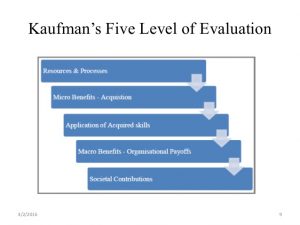Kaufman’s Five Levels of Evaluation
This Kaufman’s Five Levels of Evaluation the first level of Kirkpatrick’s Model of training evaluation. As training is the vital component for the success of any business or organization. This model of evaluation is a one-way method. It used to develop both initial and on-the-job training programme. It’s a way to evaluate a programme from the trainee’s perspective. Therefore assess the possible impacts on the society and client resultant to implementing a new training program.
The five levels:
- Input and Process- this first method is split into two parts. The first part is about enabling evaluation – its designed to evaluate the availability and quality of human, financial and physical resources. It’s the input level. While the other part is about the reaction. Thus evaluates the acceptability and efficiency of the means, processes and the methods of the proposed training program.
- Micro levels- this contains the two levels 2 and 3 basically designed for the evaluation of the small groups and individuals. The first half is about the acquisition- this evaluates the mastery and competency in a classroom setting. The other half is about the application- this evaluates the success of the utilization of the training program. The test is based on the monitoring how well the trainees’ implement the gained knowledge.
- Macro-level- this fourth level of is designed for the evaluation of the results made by contribution and the payoffs of the organization as a result of the proposed training. The overall performance of the organization and the investment returns are the means to measure the success.
- The Mega level- this measures the societal benefits of the contribution as a whole from and to the client and society’s evaluation.
This is the most advantageous method. As it’s more towards the learner’s satisfaction. Also, organizational factors impact the learner’s satisfaction.
For certification in the L&D visit –

